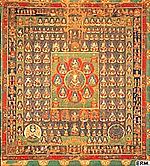List of Cultural Properties of Japan – paintings (Hiroshima)
From Wikipedia, the free encyclopedia
From Wikipedia, the free encyclopedia
This list is of the Cultural Properties of Japan designated in the category of paintings (絵画, kaiga) for the Prefecture of Hiroshima.[1]
As of 1 July 2019, thirteen Important Cultural Properties (including two *National Treasures) have been designated, being of national significance.[2][3][4]
| Property | Date | Municipality | Ownership | Comments | Image | Dimensions | Coordinates | Ref. |
|---|---|---|---|---|---|---|---|---|
| *Fugen Enmei, colour on silk 絹本著色普賢延命像 kenpon chakushoku Fugen Enmei zō | 1153 | Onomichi | Jikō-ji |  | 149.3 centimetres (58.8 in) by 86.6 centimetres (34.1 in) | 34°24′26″N 133°11′45″E | ||
| *Heike Nōkyō 平家納経 Heike nōkyō | 1164 | Hatsukaichi | Itsukushima Jinja |  | 34°17′45″N 132°19′11″E | |||
| Amida Triad Raigō, gold with blue ground on silk 絹本紺地金彩弥陀三尊来迎図 kenpon konji kinsai Mida sanzon raigō zu | Muromachi period | Hatsukaichi | Kōmyō-in (光明院) | 69 centimetres (27 in) by 36 centimetres (14 in) | 34°17′49″N 132°19′19″E | |||
| Yamanba, colour on silk, ema by Nagasawa Rosetsu 絹本著色山姥図〈長沢芦雪筆/(絵馬)〉 kenpon chakushoku yamanba zu (Nagasawa Rosetsu hitsu ema) | 1795 | Hatsukaichi | Itsukushima Jinja |  | 150 centimetres (59 in) by 83 centimetres (33 in) | 34°17′45″N 132°19′11″E | ||
| Kobayakawa Takakage, colour on silk 絹本著色小早川隆景像 kenpon chakushoku Kobayakawa Takakage zō | 1594 | Mihara | Beisan-ji (米山寺) |  | 104.7 centimetres (41.2 in) by 42.2 centimetres (16.6 in) | 34°23′28″N 132°59′59″E | ||
| Senju Sengen Kannon, colour on silk 絹本著色千手千眼観音像 kenpon chakushoku senju sengen Kannon zō | Kamakura period | Onomichi | Kōsan-ji |  | 124 centimetres (49 in) by 54 centimetres (21 in) | 34°18′20″N 133°05′29″E | ||
| Nirvana painting, colour on silk 絹本著色仏涅槃図 kenpon chakushoku Butsu nehan zu | 1274 | Onomichi | Jōdo-ji |  | 174.5 centimetres (68.7 in) by 133.5 centimetres (52.6 in) | 34°24′43″N 133°12′36″E | ||
| Nirvana painting, colour on silk 絹本著色仏涅槃図 kenpon chakushoku Butsu nehan zu | Kamakura period | Onomichi | Kōsan-ji |  | 152.4 centimetres (60.0 in) by 140.7 centimetres (55.4 in) | 34°18′20″N 133°05′29″E | ||
| Mandala of the Two Realms, colour on silk 絹本著色両界曼荼羅図 kenpon chakushoku ryōkai mandara zu | 1317 | Onomichi | Jōdo-ji | pair of scrolls |  | Kongōkai: 251 centimetres (99 in) by 185 centimetres (73 in), Taizōkai: 263 centimetres (104 in) by 183.5 centimetres (72.2 in) | 34°24′43″N 133°12′36″E | |
| Yūgyō Shōnin, monochrome on paper 紙本意白描遊行上人絵〈巻第二、第五、第六、第八/〉 shihon i hakubyō Yūgyō Shōnin e | Nanboku-chō period | Onomichi | Jōshō-ji (常称寺) | four handscrolls (2, 5, 6, 7) | 30.2 centimetres (11.9 in) by 861.5 centimetres (28 ft 3.2 in) to 1,202.0 centimetres (39 ft 5.2 in) | 34°24′45″N 133°12′13″E | ||
| Ki no Tsurayuki from the Thirty-six Poetry Immortals, colour on paper, from the Satake Collection 紙本著色三十六歌仙切〈(貫之)/佐竹家伝来〉 shihon chakushoku sanjūrokkasen setsu (Tsurayuki Satake-ke denrai) | Kamakura period | Onomichi | Kōsan-ji |  | 35.5 centimetres (14.0 in) by 78.2 centimetres (30.8 in) | 34°18′20″N 133°05′29″E | ||
| Daitsū Zenji, colour on paper 紙本著色大通禅師像 kenpon chakushoku Daitsū Zenji zō | Nanboku-chō period | Mihara | Buttsū-ji |  | 103 centimetres (41 in) by 41 centimetres (16 in) | 34°27′21″N 133°01′36″E | ||
| Landscape of the Four Seasons, ink and light colour on paper, six-panel byōbu 紙本墨画淡彩四季山水図〈/六曲屏風〉 shihon bokuga tansai shiki sansui zu (rokkyoku byōbu) | Muromachi period | Hatsukaichi | Woodone Co Ltd (ウッドワン) (kept at the Woodone Museum of Art (ウッドワン美術館)) | pair of screens; traditionally attributed to Shūbun but likely of a later date |   | 150.4 centimetres (59.2 in) by 347 centimetres (137 in) | 34°29′56″N 132°08′37″E | |
As of 18 April 2019, fifty-one properties have been designated at a prefectural level.[4][5]
| Property | Date | Municipality | Ownership | Comments | Image | Dimensions | Coordinates | Ref. |
|---|---|---|---|---|---|---|---|---|
| Kōbō Daishi, colour on silk 絹本著色弘法大師画像 kenpon chakushoku Kōbō Daishi gazō | early Kamakura period | Sera | Ryūge-ji (龍華寺) |  | 232 centimetres (91 in) by 147 centimetres (58 in) | 34°34′57″N 133°03′35″E | ||
| Mizuno Tadashige, colour on silk 絹本著色水野忠重画像 kenpon chakushoku Mizuno Tadashige gazō | 1640 | Fukuyama | Kenchū-ji (Fukuyama) (賢忠寺) |  | 120 centimetres (47 in) by 52.5 centimetres (20.7 in) | 34°29′27″N 133°22′16″E | ||
| Mizuno Katsunari, colour on silk 絹本著色水野勝成画像 kenpon chakushoku Mizuno Katsunari gazō | 1645 | Fukuyama | Kenchū-ji (Fukuyama) (賢忠寺) |  | 98 centimetres (39 in) by 46 centimetres (18 in) | 34°29′27″N 133°22′16″E | ||
| Kōbō Daishi, colour on silk 絹本著色弘法大師画像 kenpon chakushoku Kōbō Daishi gazō | Muromachi period | Fukuyama | Iō-ji (医王寺) | with an ink inscription on the back documenting its theft and recovery in 1699 |  | 113 centimetres (44 in) by 77 centimetres (30 in) | 34°30′28″N 133°23′27″E | |
| Pictorial Biography of Kōbō Daishi, colour on silk 絹本著色弘法大師絵伝 kenpon chakushoku Kōbō Daishi e-den | C15 | Onomichi | Jōdo-ji |  | 152 centimetres (60 in) by 96 centimetres (38 in) | 34°24′43″N 133°12′36″E | ||
| Senju Kannon, colour on silk 絹本著色千手観音像 kenpon chakushoku senju Kannon zō | Kamakura period | Onomichi | Jōdo-ji |  | 171 centimetres (67 in) by 82 centimetres (32 in) | 34°24′43″N 133°12′36″E | ||
Seamless Wikipedia browsing. On steroids.
Every time you click a link to Wikipedia, Wiktionary or Wikiquote in your browser's search results, it will show the modern Wikiwand interface.
Wikiwand extension is a five stars, simple, with minimum permission required to keep your browsing private, safe and transparent.